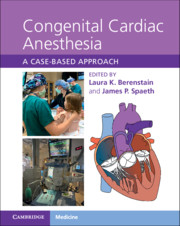Book contents
- Congenital Cardiac Anesthesia
- Congenital Cardiac Anesthesia
- Copyright page
- Dedication
- Contents
- Contributors
- Introduction
- Chapter 1 A Congenital Heart Disease Primer
- Section 1 Left-to-Right Shunts
- Section 2 Right-Sided Obstructive Lesions
- Section 3 Left-Sided Obstructive Lesions
- Section 4 Complex Mixing Lesions
- Section 5 Single-Ventricle Physiology
- Section 6 Heart Failure, Mechanical Circulatory Support, and Transplantation
- Section 7 Miscellaneous Lesions and Syndromes
- Chapter 40 Idiopathic Pulmonary Hypertension
- Chapter 41 Pulmonary Hypertension and Congenital Heart Disease
- Chapter 42 Pulmonary Hypertension and Prematurity
- Chapter 43 Pulmonary Hypertension and Moyamoya Disease
- Chapter 44 Vascular Ring
- Chapter 45 Pericardial Effusion
- Chapter 46 Kawasaki Disease
- Chapter 47 VACTERL Syndrome
- Chapter 48 Hurler Syndrome
- Chapter 49 Long QT Syndrome
- Chapter 50 Marfan Syndrome
- Index
- References
Chapter 43 - Pulmonary Hypertension and Moyamoya Disease
from Section 7 - Miscellaneous Lesions and Syndromes
Published online by Cambridge University Press: 09 September 2021
- Congenital Cardiac Anesthesia
- Congenital Cardiac Anesthesia
- Copyright page
- Dedication
- Contents
- Contributors
- Introduction
- Chapter 1 A Congenital Heart Disease Primer
- Section 1 Left-to-Right Shunts
- Section 2 Right-Sided Obstructive Lesions
- Section 3 Left-Sided Obstructive Lesions
- Section 4 Complex Mixing Lesions
- Section 5 Single-Ventricle Physiology
- Section 6 Heart Failure, Mechanical Circulatory Support, and Transplantation
- Section 7 Miscellaneous Lesions and Syndromes
- Chapter 40 Idiopathic Pulmonary Hypertension
- Chapter 41 Pulmonary Hypertension and Congenital Heart Disease
- Chapter 42 Pulmonary Hypertension and Prematurity
- Chapter 43 Pulmonary Hypertension and Moyamoya Disease
- Chapter 44 Vascular Ring
- Chapter 45 Pericardial Effusion
- Chapter 46 Kawasaki Disease
- Chapter 47 VACTERL Syndrome
- Chapter 48 Hurler Syndrome
- Chapter 49 Long QT Syndrome
- Chapter 50 Marfan Syndrome
- Index
- References
Summary
Moyamoya disease is a cerebrovasculopathy of unknown etiology characterized by chronic progressive stenosis of the arteries of the circle of Willis. An extensive collateralized circulation forms, giving rise to the smoky appearance seen on cerebral angiography (moyamoya is Japanese for “puff of smoke”). Primary clinical features of moyamoya disease, especially in children, are related to cerebral ischemia and include transient ischemic attacks and stroke. The goals of treatment are primarily to restore blood flow to the affected areas, either by direct or indirect bypass, as there is no curative treatment for moyamoya disease. This chapter details the perioperative management of a patient with coexisting morbidities of moyamoya disease, coarctation of the aorta, and pulmonary hypertension, discussing the concerns related to each and their considerations in developing an anesthetic management plan.
Keywords
- Type
- Chapter
- Information
- Congenital Cardiac AnesthesiaA Case-based Approach, pp. 331 - 337Publisher: Cambridge University PressPrint publication year: 2021

